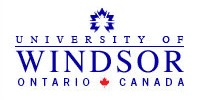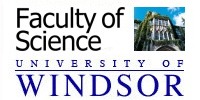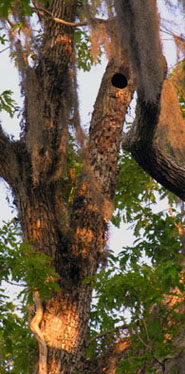Advice
for birders - In consultation with our research group,
the Florida Fish & Wildlife Conservation Commission decided not to
close any areas in the Choctawhatchee River Basin, including our
discovery and study area. Closing access to areas would
understandably anger local people who use the river for hunting and
fishing, and we want local people to be allies not adversaries.
At present, we are not releasing the specific location where we
collected evidence for the presence of ivorybills in the Choctawhatchee
River basin in 2005/2006 and where we will continue to systematically
search in 2006/2007. If you learn of the location of our study area,
please do not pass it to other ivorybill enthusiasts and certainly do
not post it on the web. Even though no areas will be officially
closed, we ask that no woodpecker seekers enter our study area.
We will be using remote sound monitoring stations in this area in
attempt to document the presence of ivorybills, and we will have a
small team of searchers engaged in a systematic search for roost and
nest cavities. Intrusions by birders will hinder these activities
making it harder for us to gather definitive proof that ivorybills
persist in this river basin.
If we encounter birders in our study area, we will ask them to leave
and suggest other areas to search. It is not worth endangering this
small population of Ivory-billed Woodpeckers to try to get this bird on
your life list. Our observations of bark scaling and large
cavities from I-10 to the Choctawhatchee Bay suggest that ivorybills
may be widespread in the Choctawhatchee River Basin, and there are many
areas to explore outside of our small study area with great potential
for ivorybills. Below, we suggest several places to search.
If birders spread out, the impact on any given area will be
small. If birders crowd into one spot, ivorybills will be driven
out of that area. We ask that you put the interest of the bird
first.
We also ask that you do not mimic the sounds of Ivory-billed
Woodpeckers anywhere in the Choctawhatchee River Basin. There is
no evidence that mimicking ivorybills will increase your chances of
seeing one, but having birders in the area playing tapes will certainly
diminish the outdoor experience of other bird watchers. If you
hear a kent call or double knock in this swamp, you want to be
confident that it is not coming out of the tape recorder of another
birder.
|
|
Suggested
areas to search for Ivorybills -The Choctawhatchee River
Basin is not a birder-friendly area. There are few motel rooms
and only a couple of small restaurants in the entire region. The
Choctawhatchee River bottomlands have no walking trails or canoe
trails. There are no information centers, observation towers, or
even signs on most of the dirt roads in the area. For anyone
venturing off roads and especially venturing forth in a canoe or kayak,
we strongly recommend that you get topo maps of the area and carry a
GPS. The DeLorme Atlas of Florida is helpful for finding road
routes but is useless for details of the river and swamp. It is easy to
get lost, and swift currents and many submerged logs make boating
dangerous. Poisonous snakes including water moccasins and two species
of rattlesnakes are common, as are alligators. There are many
feral pigs and a few bears in the forest.
Places to search
For walkers/casual boaters
1. Tilley Landing. A gravel road runs
from Highway 81 east into mature swamp forest ending at two small canoe
launches that feed into Lost Lake, a beautiful oxbow lake. This
area has numerous large cavities and scaled trees, including feeding
sign on spruce pine along the road, suggesting that it is regularly
used by Ivory-billed Woodpeckers. Walking the gravel road from
the upper parking area (at the Choctawhatchee Wildlife Area sign) to
the end of the road is an excellent way for birders who do not want to
kayak or wade to search for ivorybills. This road first skirts
the edge of the swamp forest with pine plantation on the left but then
plunges into maturing swamp forest. For the novice kayaker or
canoeist, touring Lost Lake is a fairly safe means to paddle around in
the swamp in an area that may have ivorybills. Do not venture
beyond the lake into the flooded forest unless you are competent with
your boat and a GPS. Lost Lake lies in a large swamp forest, and
it is easy to get lost when the forest is flooded. The three
parking lots here that can accommodate many automobiles.
For Kayakers and canoeists (and
motor boaters)
2. Dead River Landing. This is a
favorite place for local folks to launch boats and camp. The
waterways around the landing have huge cypress and the forests in this
area are mature. It is very easy to get lost if you venture out
in a boat in this area so bring a map and a GPS. Both feeding
sign and large cavities suggest ivorybill activity in this area.
The parking lot can accommodate about 20 cars.
3. Lower
Holmes Creek and the Boynton Cutoff. At the end of Road
284A on the east side of the Choctawhatchee River are two access
points. Shell Landing provides access to Holmes Creek about one
mile above where it meets the Boynton Cutoff (which carries more water
than the channel officially called the Choctawhatchee River).
South of the end of this road is a dirt road leading to a boat ramp on
the Boynton Cutoff. There are many large cypress and mature
hardwood forests in this area with lots of potential Ivory-billed
Woodpecker sign. The river and creek here can be swift and
dangerous. Note that contrary to what is shown in the DeLorme
atlas, 284A does not cross Holmes Creek.
4. Cedar Tree
Landing and Rocky Landing. These landings are off of HWY 79 on
the east side of the river. Habitat at these landings is marginal
but directly across the river is nice forest with high ivorybill
potential.
5. Reason
Lakes. There is a large boat ramp on the west bank of the
Choctawhatchee River where Highway 20 crosses it. To move from
the boat launch to the lakes paddle south for a hundred yards or so
then turn north and move up an eastern channel under the highway then
paddle back south along an even more easterly channel, back under the
highway and into the Reason Lakes area. The tupelo and cypress in
this area are impressive with interspersed hammocks of oak, sweetgum,
and spruce pine. Many large cavities and scaled trees suggest
that ivorybills regularly use this area. This is one of the most
scenic areas along the river. It is very easy to get lost in this
maze of oxbow lakes and dry ground.
6. Smokehouse
Lake Road. Off county road 3280 south of the town of
Bruce. At the end of Smokehouse Lake Road is a small landing
where boats can be launched for a $3 fee. The areas west of this
landing are among the most remote and wild in the entire basin, and
this is an area with abundant sign of ivorybills.
7. East River
and East River Island. There is limited access to this
vast swamp wilderness. Only physically fit, experienced kayakers
or canoeists with good abilities to navigate in remote areas should
enter this area. Much of the 10 square miles of forest on East
River Island is mature oak, tupelo, and spruce pine with scattered huge
cypress. The island has no roads or trails. Rolek and Hill
observed abundant evidence of ivorybills in this area. For the
true swamp experience and for the greatest chance of seeing or hearing
ivorybills, East River is hard to beat. |





























